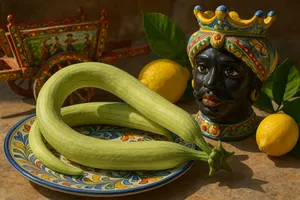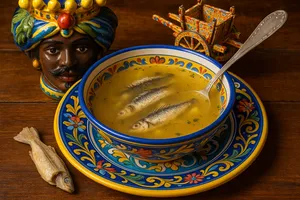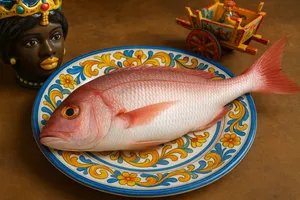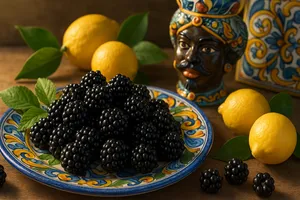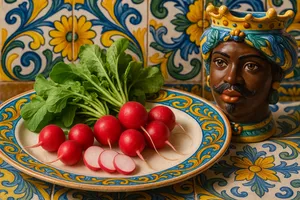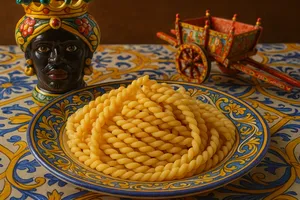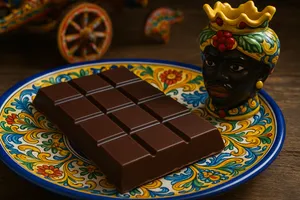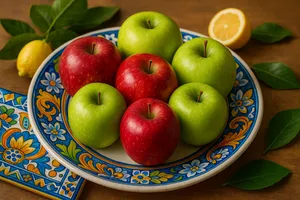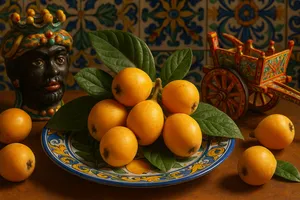Overview
Soles, called “linguate” or “linguati” in Sicilian (a reference to their elongated, tongue-like shape), are flatfish belonging to the Soleidae family. They are characterised by an oval, elongated body completely flattened sideways, with both eyes on the same side (the right, in true soles), a brownish-grey camouflaged colouring on the eyed side, white on the blind side resting on the seabed, and sizes ranging from 20 to 50 cm. They live on sandy Mediterranean seabeds, where they blend perfectly into the surroundings, half-buried in the sand. In Sicilian cookery, soles are considered a prized, delicate, refined fish, reserved for special preparations and important occasions. The flesh is white, lean, tender, with a sweet, delicate flavour and a firm yet yielding texture. Traditional preparations include meunière (lightly floured and pan-cooked in butter), baking, frying and boiling.
Sole fishing in Sicilian waters is carried out with bottom trawls, gillnets and bottom longlines. Freshly caught soles have very firm flesh and an extremely delicate sea aroma. They require skill in preparation: cleaning and skinning can be labour-intensive, but the result is pure, bone-free, immaculate white fillets. Distinguishing between true sole (Solea solea or Solea vulgaris), Turkish sole, scaldfish, and turbot (other flatfish) is important for quality and price. True sole is more prized and expensive, with superior flesh. Any Sicilian who loves refined fish has memories of soles: the tenderness of the flesh that melts in the mouth, the clean flavour free of strong notes, the elegance of a perfectly golden fillet. Soles represent high-level seafood cookery, a celebration of delicate flavours and mastery in simplicity.
Characteristics
Soles have an elongated oval body (somewhat reminiscent of a tongue or a shoe sole, hence the name), completely flat, with both eyes on the right side (in true soles). The eyed side is brownish-grey with possible mottling or camouflage streaks; the blind side is bright white. Typical dimensions are 25–35 cm in length, weighing 150–400 grams. Large specimens may reach 50 cm and 1 kg.
The flesh is white and very lean (1–2% fat), extremely tender, with a sweet, delicate flavour and a firm texture that flakes easily. They have very few bones: a flat central spine and small lateral bones, easily removed when filleted. The scent should be extremely delicate, never strong.
Fresh soles have a firm body, intact skin with vivid colouring, and a delicate aroma. Older fish have limp flesh, a strong smell, and dull or peeling skin.
True sole vs. other flatfish
Several flatfish are sold commercially, with differing qualities and prices:
True sole (Solea solea/vulgaris): An elongated oval body, eyes close together on the right side, and a characteristic dark spot at the base of the pectoral fin on the eyed side (not always visible, but a distinctive marker). Small mouth. Very fine flesh, delicate flavour. The most expensive (25–50 euros/kg or more).
Turkish sole or scaldfish (Solea lascaris and other species): Similar to true sole but slightly less prized, good flesh, less expensive (15–30 euros/kg). Often sold simply as “sole”.
Turbot (Psetta maxima): A rounder rather than elongated body, eyes on the left side, a rough surface with tubercles, larger size. Extremely fine flesh, possibly superior to sole, with a firmer texture. Expensive.
Plaice (Pleuronectes platessa): A roundish body, eyes on the right side, and distinctive orange spots. Good flesh but less prized than sole and turbot. Less expensive.
Flounder (various species): Various similar flatfish, less prized, with more watery, less flavourful flesh. Economical.
In Sicily, “linguata” can refer generically to flatfish, not just true sole. Always verify the species for the right quality/price balance.
Fishing and seasonality
Soles live on sandy or muddy seabeds, from shallow waters to depths of 200 metres. They spend the day half-buried in the sand, camouflaged, and become active at night to feed on worms, molluscs, small crustaceans and small fish. Their ability to camouflage is extraordinary: they can change colour and pattern to match the seabed.
They are caught with bottom trawls (the most common but environmentally impactful), gillnets and bottom longlines. Fishing requires knowledge of seabeds and the habits of soles.
Soles are available all year round, but the best periods are spring (March–May) and autumn (September–November). During these months the flesh is firmer and more flavourful.
Cleaning and preparation
Soles require specific cleaning:
Complete method (skinning and filleting):
1. Rinse the fish under cold water.
2. Skinning: make a small cut at the base of the tail on the dark side, lift the skin and pull towards the head (it comes away like a glove). Repeat on the white side. Sole skin detaches relatively easily.
3. Remove head, fins and innards by cutting behind the head and along the belly.
4. Fillet: make a cut along the central dorsal spine, remove the fillets (two per side, four total) by sliding the knife between flesh and bone.
5. Rinse the fillets gently.
Simple method (without skinning):
Some cook whole soles without skinning, simply gutted. The skin protects the delicate flesh during cooking and is removed on the plate. Easier but less refined.
Many people buy soles already cleaned and filleted from the fishmonger to avoid the labour.
Culinary use
Sole meunière
A classic French preparation adopted in Italy. Whole soles or fillets are lightly floured, cooked in a pan with butter (or oil) until golden, and seasoned with lemon juice, parsley and melted butter (or oil). It is a simple preparation that enhances delicacy. Serve immediately.
Baked sole
Whole soles or fillets baked with oil, lemon, white wine and herbs. The gentle cooking preserves tenderness and moisture.
Fried sole
Fillets floured or battered and fried in hot oil. They become crisp and golden. Served with lemon. Less common for such a prized fish (gentler methods are preferred), but tasty.
Boiled sole
Whole soles gently boiled in a court-bouillon (vegetable broth with wine and aromatics) and served with sauces (mayonnaise, green sauce, tartare sauce). A refined preparation for banquets.
Gratinated sole fillets
Fillets placed in a baking dish, topped with breadcrumbs, Parmesan, herbs and oil, then gratinated in the oven. They develop a golden crust while remaining tender inside.
Sole rolls
Fillets filled with a stuffing (minced prawns, ricotta, spinach, mushrooms depending on the recipe), rolled up and cooked in the oven or pan. An elegant, elaborate preparation.
Perfect cooking of soles
Soles require gentle, rapid cooking to preserve tenderness:
Pan (meunière): 3–4 minutes per side over medium heat in butter or oil. The flour protects and aids browning.
Oven: 10–15 minutes at 180–200°C with seasonings.
Boiling: 8–10 minutes in a gently simmering court-bouillon (not boiling).
Frying: 2–3 minutes in oil at 180°C for thin fillets.
Perfectly cooked flesh is opaque, white, and flakes gently without falling apart. Overcooking makes it dry and rubbery.
Storage
Fresh soles keep in the coldest part of the refrigerator, on ice, for a maximum of 1–2 days. They must be eaten very fresh.
Cooked soles keep for 1–2 days in the refrigerator in a sealed container.
Soles can be frozen: cleaned and gutted (preferably filleted), in airtight or vacuum-sealed bags, they keep for 2–3 months. Defrost slowly in the refrigerator. Freezing slightly affects their delicate texture but is acceptable.
Buying tips
Prefer fresh soles (not previously frozen) when possible. Check freshness: firm body, bright eyes (if whole), intact skin with vivid colours on the dark side and bright white on the blind side, and a very delicate aroma.
Check the species: true sole is more prized and costly. Ask the fishmonger for origin and exact species. The dark spot at the base of the pectoral fin is a sign of true sole (not always visible once cleaned).
Ideal sizes are medium (25–35 cm, 200–400 g): they have finer flesh. Very small soles offer little meat; very large ones may be less tender.
The high price (20–50 euros/kg for true sole) reflects quality and scarcity. If the price is too low, it is probably not true sole but a less prized species.
Nutritional properties
Soles are extremely lean fish: 100 g of flesh provide about 70–85 calories. They contain 16–18 g of very high-quality protein, 1–2 g of fat and zero carbohydrates. They are rich in B vitamins (especially B12 and B3), vitamin D and minerals such as phosphorus, potassium, selenium and iodine.
They are highly digestible, suitable for low-calorie diets, convalescents, children and the elderly. The proteins are complete. The low fat content makes them ideal for those seeking light fish.
Like all fish, they contain omega-3 fatty acids (though in smaller amounts than fattier oily fish), beneficial for cardiovascular and brain health.
Soles in tradition
Soles have long enjoyed a reputation as refined, prized fish for special occasions. They were never (and still are not) everyday fish but reserved for festive meals and quality restaurants.
In classic French cuisine, sole is a noble fish, starring in elaborate preparations (sole meunière, filets de sole Normande, sole Véronique with grapes). Sicilian cuisine has adopted simpler but equally respectful methods.
Soles were considered suitable for delicate palates, children and the unwell because they are highly digestible and not strongly flavoured. They were a “safe” fish for those who dislike strong-tasting seafood.
Curiosities
The name “sole” derives from the Latin “solea” (shoe sole), referring to the flat, oval shape reminiscent of a sole. In Sicilian, “linguata” comes from “lingua” for the elongated shape.
Soles are born as “normal” fish with symmetrical bodies and eyes on opposite sides. During metamorphosis (a few weeks after birth), one eye migrates to the other side, the body flattens and the fish adapts to life on the seabed. It is an extraordinary transformation.
Soles can change the colour of their upper side to match the seabed in minutes. They have specialised cells (chromatophores) that expand or contract pigments. They can imitate fine sand, gravel or mud.
In Greek mythology, it was said that flatfish were flattened by the foot of Poseidon, god of the sea—a fanciful explanation of their peculiar shape.
An old mariners’ saying goes: “Linguata d’oru, poi du mari” (Golden sole, treasure of the sea), a reference to the high value of this fish and the golden hue it takes on when cooked.
Soles are long-lived fish: they may live over 20 years in the wild. Very large specimens are old and have “seen” much of the sea. Age is determined from the otoliths (tiny bones in the inner ear) which have growth rings like trees.
Intensive trawl fishing for soles raises environmental concerns: dragging nets along the seabed destroys habitats and catches non-target species (bycatch). Soles from sustainable fisheries or aquaculture are more responsible alternatives.
In popular language, “to be as flat as a sole” means to be very thin, lacking substance—a playful expression based on the fish’s shape.


